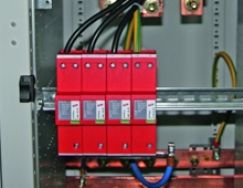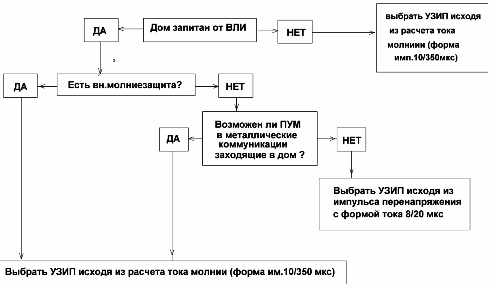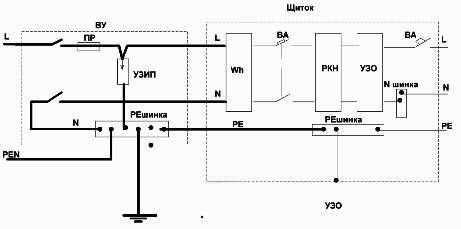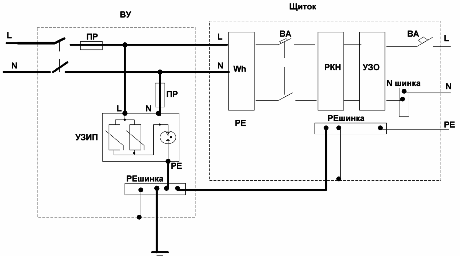Categories: Electrician at home, Safety precautions
Number of views: 41049
Comments on the article: 5
Electrosafe private house and cottage. Part 4 (ending). SPD selection examples
Beginning of the article:
Electrosafe private residential building and cottage. Part 4. Surge Protection
 Let's first understand in more detail what we will deal with. Let's start with overvoltage impulses. For calculations and the choice of SPDs, we need to know that there are lightning current pulses distinguished from the current pulses of all other overvoltages. Figure 1 shows what their main difference is - the lightning current pulse is almost 17 times longer than the overvoltage pulse, that is, it has a much greater power.
Let's first understand in more detail what we will deal with. Let's start with overvoltage impulses. For calculations and the choice of SPDs, we need to know that there are lightning current pulses distinguished from the current pulses of all other overvoltages. Figure 1 shows what their main difference is - the lightning current pulse is almost 17 times longer than the overvoltage pulse, that is, it has a much greater power.
Next, I will list some general recommendations based on the practice of using SPD:
1. Categorically it is impossible to use circuit breakers to protect SPDs from accompanying currents. Only fuses.
2. Class 1 SPD should preferably have a monoblock design (without removable modules).
3. An SPD for a lightning current greater than 20 kA (10/350 μs) should be based on the arresters.
4. The cover in which the SPDs are installed should be metal.

Now we will use the SPD selection algorithm presented below.
Fig. 2. Selection scheme for SPD
Since when we energize the house from VLI we have a TN-C-S grounding system, we must install an SPD between the phase wire and the PEN wire (at distances of more than 30 meters from the place of separation of the PEN wire to the equipment to be protected, protection between N and PE wires is also necessary).
EXAMPLE 1. The house is powered by VLI
There is no external lightning protection. There are no metal communications entering the house. Grounding system TN-C-S.
In this example, we do not have the likelihood of a direct lightning strike (PUM) not from the VLI, not from the external lightning protection, not from the communications (water supply, etc.). In this case, only overvoltages with a current shape of 8/20 μs are possible, which allows us to choose an SPD in one housing whose protection is 1,2,3 classes and place it inside the house.
We choose, for example, an SPD combined protection class 1 + 2 + 3 DS131VGS-230 (the function of suppressing the pulsed lightning current with a form of 10/350 μs at 12.5 kA in it is redundant for our example). NOTE: Surge protection surge protector with a current shape of 8/20 μs is selected from the range of 5-20 kA. In order not to consider the number of thunderstorm days, etc., it is better to immediately take an SPD of 20 kA.
EXAMPLE 2. The house is powered by VLI.
There is no external lightning protection. A metal pipe enters the house, for example a gas pipeline (without an insulating insert). Grounding system TN-C-S.
With PUM (100 kA) into such a pipe, 50 kA will go to the right, the other 50 kA to the left of the place of lightning strike. Upon entering our house, 50 kA will be divided into two equal parts: 25 kA will go to our grounding device, and the other 25 kA will also be divided into two equal parts: 12.5 kA will go to the PEN conductor, and the other 12.5 kA through our SPD to the phase conductor . Therefore, we need a 12.5 kA surge protector with a pulse shape of 10/350 μs. We choose an SPD that is the same as in the example above, but now the function of suppressing the lightning current of 10/350 μs by 12.5 kA is not redundant for us, but simply necessary.
EXAMPLE 3. The house is powered by VLI. There is external lightning protection. There are no metal communications entering the house. Grounding system TN-C-S.
With PUM (100 kA) into the air terminal, 50 kA will go to our grounding device, the remaining 50 kA will be divided into two equal parts: 25 kA will go to the PEN wire, and the other 25 kA will go through our SPD to the phase wire. Thus, we need a 25 kA SPD with a pulse shape of 10/350 μs. We choose, for example, an SPD combined protection class 1 + 2 + 3 DS251VGS-300 in which the pulse lightning current is 25 kA with a pulse shape of 10/350 μs.
EXAMPLE 4. The same as in example 3, but a metal communication enters the house (for example, a water supply pipe).
Then, with PUM in the air terminal (100 kA), 50 kA will go to our grounding device, and the remaining 50 kA will be divided into two parts: 25 kA will go to the ground through the water supply pipe (there is no insulating insert), and the remaining 25 kA will also be divided into two parts; 12/5 kA will go to the PEN conductor, and the other 12.5 kA through our SPD will go to the phase wire. Select the SPD as in example 2.
The common feature in all these examples is that the house is powered by VLI, which means that PEN wire breakage is impossible and the appearance of a voltage of 380 volts on the input is also unlikely, so you can choose an SPD for the maximum operating voltage of the network. It is also seen that the SPDs have relatively small currents, which means they can be safely installed inside the house. One SPD between the phase wire and the PEN wire will be enough (meaning the small distances in our house).
Now we will consider options when our house is powered from overhead lines (from an overhead line made with bare wires). In this case, the main danger from PUM threatens us from the overhead line itself.
Do not forget that when powering the house from overhead lines, we have a TT grounding system, and therefore protection against overvoltage pulses both between the phase conductor and ground, and between the neutral conductor and ground is necessary (protection between the phase conductor and the neutral conductor is recommended if necessary).
First you need to pay attention to how the branch to the input is made. We need this branch to be insulated, separate (with a gap between the phase and zero wires) and a cross section of at least 16 mm. HF
Let's now see where PUM is possible. Since we made the branch to the input with an ISOLATED wire, we exclude the PUM into it. If we have cut the wire at the insulator, then PUM is possible in this place (the worst option is half a lightning current of 50 kA will appear on the phase wire of the house entrance).
In order to exclude this possibility, it is necessary to cut the input wires inside the house, and connect the PE bus of the shield to the grounding device so that PUM is excluded from this conductor outside the house. If we do not do this, then we will need a 50 kA SPD with the shape of it. 10/350 μs. It remains PUM in the bare wire of the overhead line on the highway. In this case, 50 kA will go to the left, and the other 50 kA - to the right of the place of lightning strike on the overhead line. Having reached our pillar, the lightning current will be divided: 25 kA will go further along the highway, and the other part of 25 kA will turn to our house. If your pole is the last on the OHL, then all 50kA will go into your house. Based on all these nuances, you need to decide which one to choose SPD.
So, based on 50 kA and the fact that when a PEN wire breaks on the overhead line, a voltage of up to 380 volts can appear at our input, you can choose an EZETEK ET B 50 SPD (1 + 1) for a working voltage of 385 volts.
After choosing the right SPD, it is necessary to follow the recommendations of the manufacturer, which gives schemes for its inclusion in various grounding systems (TT, TN-C-S) and other necessary information.
Summing up, we see that competently performing surge protection is not an easy task and requires a well-considered solution, taking into account many factors. Incorrectly selected SPD, installation, conductor cross-sections, etc. - and such protection will do more harm than its absence.
Fig. 3. The inclusion circuit SPD in with. TN-C-S
Fig. 4. The inclusion circuit SPD in with. TT
Determine the need for a fuse in the circuit zero wire-clamp N SPD can be based on the following considerations. Imagine there is a thunderstorm, a heavy wind and a break in the PEN wire on the overhead line. A phase comes to our neutral wire. Lightning strikes our L wire and an SPD is triggered. Through the arrester, both the lightning current and the current (accompanying) will flow through the circuit: zero wire (on which the phase sits) - PR - arrester - Reshina - earth.
If at the moment the accompanying current passes through zero, the arrester does not interrupt the current, then a short circuit will occur and then the fuse should trip, protecting this circuit.If our grounding device has a resistance of 10 Ohms, then the accompanying current will be 220: 10 = 22 amperes, and if 1 ohm, then 220 amperes. If the passport on the SPD indicates that the arrester can withstand the accompanying current more than this value, then you can do without a fuse.
Mironov S.I.
See also at i.electricianexp.com
:



